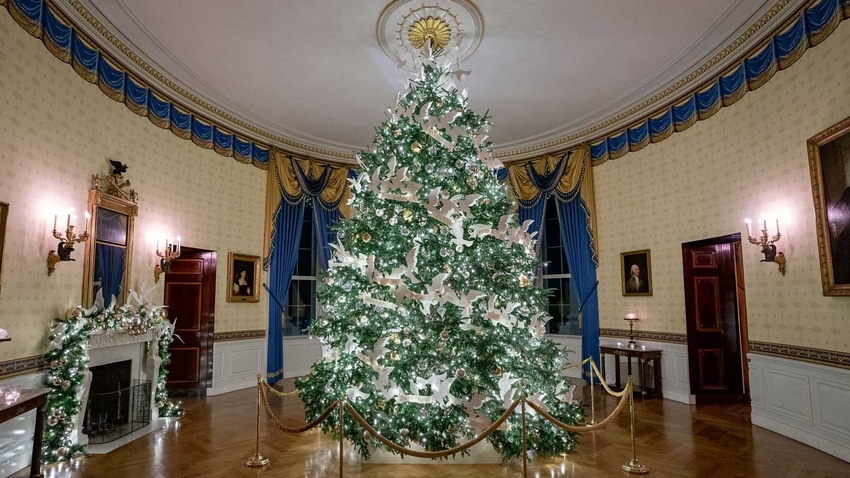December 6, 2021

Ranked second in the United States in the number of Christmas trees harvested and cash receipts, it’s no wonder the White House came to North Carolina for its Christmas Tree this year. Peak Farms in Ashe County won Grand Champion Tree and the honor of having one of its finest, and largest, Fraser firs in the Blue Room of the White House.
“It’s the greatest honor we can have,” says Rusty Estes, owner of Peak Farms in Ashe County. “Presenting the tree, we’re representing all the Christmas Tree farmers from all over the country.”
For Estes and his son Beau, this isn’t his first time a Peak Farms tree has decked the White House halls. In 2008, Peak Farms won the national tree contest and presented their Fraser Fir to the Bushes. Four years later they won again, presenting to the Obamas, and in 2018 they won Reserve Grand Champion and presented a tree to Vice President Pence and his family. This year’s Reserve Grand Champion honor went to Cline Church Nursery in Fleetwood, N.C.
With North Carolina having several wins under its belt for Grand Champion and Reserve Grand Champion Christmas Tree, what’s the secret to producing these award-winning Fraser firs?
We’ve all heard the phrase, “It takes a village” and in this case, the village includes North Carolina tree growers, NC State University researchers and NC State Extension.
Since 1989, Christmas tree research has been centered on fertilization, ground covers, bud abortion, needle retention, , shearing practices, vegetative management, integrated pest management, post-harvest quality, clonal archive and genetic tolerance to insect pests. The work is done at the Upper Mountain Research Station in Ashe County, which has also established a Fraser fir seed orchard using genetically advanced material from the breeding program at NC State.
Some of those research trials have been conducted at Peak Farms.
“NC State comes to our farms and does herbicide and insect tests. They conduct the studies and whatever they learn helps me as a farmer save money and have a better product,” Estes shares of the long-standing partnership with Extension and NC State.
As mentioned, NC State has helped North Carolina tree producers enhance needle retention for the Fraser fir. The needles are soft and pleasant to touch and the branches are sturdy enough to hold some of those larger, heavier ornaments. But getting the right shape takes a little more finesse. The iconic shape you get at a tree lot or store is the result of skillful trimming and shaping, not Mother Nature.
“We trim everything with a sheer knife,” says Estes. But the sheer knife only goes so high and then the job is left to the pruners. “You cut one limb at a time. I could trim a 7- or 8-foot tree in a few seconds.” And larger trees like the 18.5-foot tree going up in the White House? “We’ll have a guy up there trimming for about an hour.” That’s one hour per tree.
Believe it or not, Estes says Peak Farms begins trimming all of their trees in July. Who knew it was such a lengthy process to get that perfect triangle shape?
Essentially, the first lady is the only judge that matters when it comes to selecting the White House Christmas Tree. It’s all about having the right tree for that year’s theme.
“The first lady asked for a smaller and slimmer tree this year,” Estes shares. But like everyone else, Estes says the White House wants to know how sturdy the branches are. He says they are also looking for a tree with nice color, good needle texture and that’s free of insects. All of which NC State has helped to perfect over the years. Oh, and let’s not forget about the long-lasting aroma of the North Carolina Fraser fir. The president, first lady and guests will get to enjoy that fresh scent throughout the holiday season.
Source: North Carolina State University, which is solely responsible for the information provided, and wholly owns the information. Informa Business Media and all its subsidiaries are not responsible for any of the content contained in this information asset.
About the Author(s)
You May Also Like




